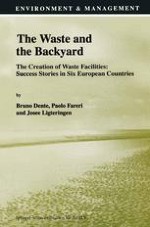Controversies concerning the siting of facilities for the disposal and treatment of hazardous but also domestic waste are widespread in all of the industrialized countries. The paradoxical situation of projects that are needed for environmental reasons and are opposed on environmental grounds has been addressed by scholars and by policy-makers searching for solutions. However, only in a few cases have waste disposal facilities actually been built and made operational.
The aim of the book (which illustrates the results of a research project financed by the EU-DGXII) is to investigate the decision-making processes for the siting and creation of waste facilities, in order to identify the factors for predicting success. Adopting a Public Policy Analysis approach the book presents six cases of successful decision-making on waste facilities siting in France, Italy, The Netherlands, Spain, Switzerland and Slovenia, drawing lessons for the redefinition of public policy-making in the field of waste treatment.
The conclusions of this book are interesting for all fields of public policy where conflict is a relevant problem. This book is also of interest to scholars in the environmental field, as well as in public policy analysis, and to practitioners and (public or private) actors involved in environmental policy.
